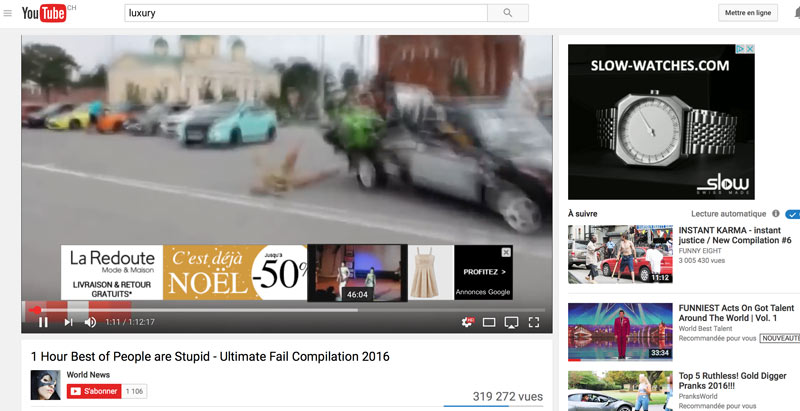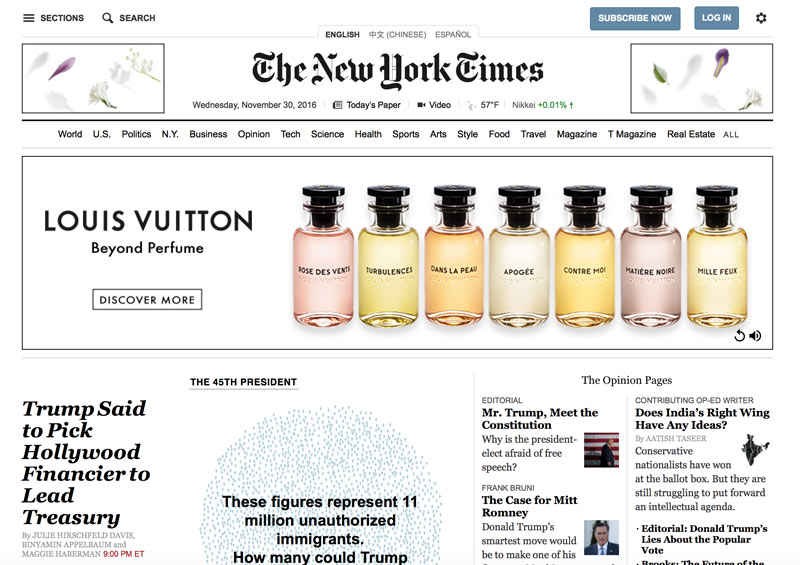
Digital is evolving is such ways that today we can target and track people in ways that we would not imagine 5 to 10 years ago. Barbarian words such as sequential targeting, re-targeting, re-marketing are current vocabulary for any good digital marketer. The king of all barbarian words would definitely be Programmatic. You can also call it automatic advertising as per the nature of the activity. We can see that today in the world more than 50% of total ad spending in digital is done via programmatic. 27.7 Billion USD is dedicated today for Programmatic buying, from which a large majority is concentrated in the US.

The main idea of programmatic is to focus on the audience targeting which brings the “environment” in a secondary position. The goal being to reach the right person with the right message no matter where this person is. It is called automatic advertising as only machines can deal with the mechanics. Basically the advertising management system needs to identify in a couple of seconds (the time the webpage loads) who is the person visiting that website, which profile and which message should be delivered to him. Behind programmatic there is the aim to optimize the media investment. Each dollar should be invested to deliver the best message possible to the best audience. The end result being a better ROI and potentially better CTR driving into sales. Who is using programmatic buying today?
- 96% of top 50 online retailers
- 9 out of 10 automotive makers
- More than 50 pure e-tailers
- Top Electronic consumer goods.
From a brand perspective here are the top 10 Brands with the most spent in programmatic worldwide:
- AT6T
- Zalando
- American Express
- Verizon
- Chrysler
- SouthWest Airlines
- Dell
- Toyota Motor Corporation
- Unilever
- General Motors Corporation
(source: Adweek)
Luxury brands are already running programmatic activity, including the likes of Burberry and Calvin Klein (who have arguably been ambassadors within this sector). Whereas brands with more flexible budgets often have the luxury of strategically placing programmatic underneath the funnel of more impactful advertising, using programmatic to cover reach and re-targeting.
Most of luxury brands will stay away from Programmatic. In times where budgets are tight, Programmatic might represent an interesting approach to maintain a certain reach and visibility. Nevertheless, the battlefield of Luxury Brands is not necessary on ROI. Several points makes programmatic non-valid for Luxury today.
Domination and uniqueness are not achieved via programmatic
What motivates luxury brands to launch digital campaigns? Most of luxury brands believe that the web can provide them a space to tell their stories, to connect to their customers. This direct to consumer approach allows most of luxury brands to create the dream, to have a story-telling approach and to control the environment. Another important point is also the media landscape domination. Luxury brands crave for dominant image among competition as well as to be perceived as innovative, original and to make a long story short: unique. With Programmatic buying you loose this uniqueness as you enter a system that will not allow you to surface higher than the average advertiser.
It is not all about audiences. Environment counts
By embracing Programmatic buying your main focus will be the audience you wish to reach. Performance and ROI will be measured against the audience affinity and the right targeted group you reach. Is this sufficient for luxury brands? Not really. Something that is key to any brand in the luxury industry is what we call the environment. This means the quality and the proper editorial environment in which the advertising message will be displayed. In the below example we can see a watch brand displaying its ad that was bought via programmatic. The aim of this brand was to reach a luxury audience with its advertising message. What happened?
Based in the audience criteria choice, the ad was displayed on Youtube aside of a video called “1 Hour Best of People are Stupid – Ultimate Fail Compilation 2016”. And on top of it we get a in-ad format inside the video about another brand. As you can notice in the screenshot below, the keyword searched was luxury. No idea how this video came in but in any case no luxury brand would clearly pickup this ad placement in full consciousness. The user being a luxury customer will have a bad perception of the watch brand or think it is a very cheap, low end product.

There is a clear topic that Programmatic gurus have completely forgot. It is the fact that luxury brands wish to choose which moment is the best to connect to their audiences. Most of luxury brands know that at one point of the user journey, they are reaching their customers as they regularly buy products from them. The main question is at what precise moment should they reach a specific customer? Probably when the customer mindset will be the best.
Let’s take a second example of what a luxury brand could do at its best. Here below a second screenshot about a ad campaign for Louis Vuitton Fragrances. As we can see here, today, Louis Vuitton took the homepage of the International New York Times. Working directly with the publisher, he achieved the following:
- Craft the message and the creative asset to look beautiful
- Dominate the page completely by taking all ad units (5 ad placements)
- Be in a safe and proper environment
- Reach the readership of the INYT (who we assume have a potential great affinity with the brand)

Luxury brands have the fire power to take opinion leader media dominance. By crafting a specific message to blend into the editorial environment the display advertising message looks more qualitative and even if you do not know the brand, it procures a feeling of luxury. So Luxury brands need to craft their messages as it is not only about the numbers.
Media relationships vs audiences buy-out
One interesting fact with programmatic is the fact that you skip the media relationship in order to get immediate access to audiences. No need of phone calls to the media or trying to negotiate a homepage takeover. You place your order in the DSP and let the magic of technology occurs. For luxury brands that have been crafting their relationship with media owners it is a hard step to take. You loose all the magic of a great integrated operation that is only possible if you work hand in hand with the publisher. In a world where anyone can buy a banner on a website (it is just a matter of money), luxury brands need to stand out. They need to differentiate themselves by proposing original and beautiful display ads.
100% Share of Voice, impossible mission?
Most of luxury brands wish to get a strong idea of exclusivity. In digital advertising this means 2 things, either getting an original format or a unique integration of the website but in general it means they are not sharing the space with other brands. So when Louis Vuitton takes the space in the above example on the INYT homepage, this means the brand will take over all the ad placements in the page. It can be also an entire section buy-out and even a total site buyout. It is what we call 100% share of voice (SOV). Luxury brands are keen to obtain this as they can do a better work by playing with creative synergies. Obviously it means that the publisher will allocate 100% of its ad inventory to the brand. Now with the programmatic evolution, publishers might dedicate a certain % of their ad inventory to programmatic buying. Some companies are dedicating between 5 to 10% of all ad placements to exclusive automatic buying. This means that when a luxury brand wishes to buy-out a specific page at 100%, they might end up sharing the space with other brands, potentially a competitor. Publishers can build black-lists, blocking certain advertisers to appear, but any advertiser that is not in the list can potentially be displayed. So it requires a lot of work and relationship to keep things appropriate. Sometimes it is in deed impossible mission.
Viewability and cheap inventory, things change.
For a very longtime, programmatic buying was considered as delivering a poor and cheap placement within websites. Publishers would offer to programmatic all the junk inventory they usually do not succeed to sell to their premium customers. We are speaking about bottom pages banners, hidden formats in deed subsections, etc… Things have slightly change. Today the concept of viewability is probably the strongest topic of all. According to Kline, between 25 to 60% of any ad campaign is not seen properly by human beings. This concerns ad placements that are not seen by people because they are to low in a page for example. The page and the ad loads, which generates an impression but nobody really see it. There are many reasons why an ad impression might not get viewed. These include:
- The user does not scroll down a page, enough to view the ad.
- The user clicks to another web page before the ad finished loading.
- The user scrolls too fast.
- The ad loads outside of the browser’s viewport.
- The user opens a non-mobile optimised web page on a smartphone or tablet.
- The user minimises the browser.
- The user opens another browser tab or window.

This made the pockets of publishers get richer and richer. The maths is easy. You have a homepage. That homepage generates 1Million impressions. If you have 5 ad units in that page, publishers will sell you 5Million impressions, no matter which position the ad units are. Probably people might only see the ones above the fold when they land in that page. it might be only one. Naturally, brands know this and now things are changing. true viewability is important and nobody wants to pay for nothing. So Programmatic is prepared to deliver viewable ads. Browser technology helps to measure when an advertising unit was truly seen by a real person. At the same time, this shows how programmatic get intrusive in a traditional media plan, meaning that you end up with other brands owning certain positions.
Publishers are not victims, they are the executioners.
Each time you talk with publishers about programmatic, specially if you are fighting against it, they will always take a position like “sorry there is nothing we can do“. Well you sold your inventory to programmatic buying, you did not get stolen right? So it shows publishers also have their interest to have programmatic developed. There is a temptation to plug computers together and just cash the money without even talking to someone (I mean a real person). Nevertheless, publishers have the responsibility to what users will experience in their websites. The quality of display and the brands relevancy should be kept at their highest level.
In conclusion, programmatic is not really ready to deal with Luxury brands. The luxury industry has different expectations that is not all based on performance and audiences. Obviously digital media allows to measure, track and report on hundreds of metrics, which brings a strong visibility on ROI. Nevertheless, luxury brands have also an obligation to showcase a certain idea of exclusivity, quality and innovation.
Jose Amorim

Info sourced at Kline, Euromonitor, Forbes, Adweek and wikipedia, All content is copyrighted with no reproduction rights available. Images are for illustration purposes only.